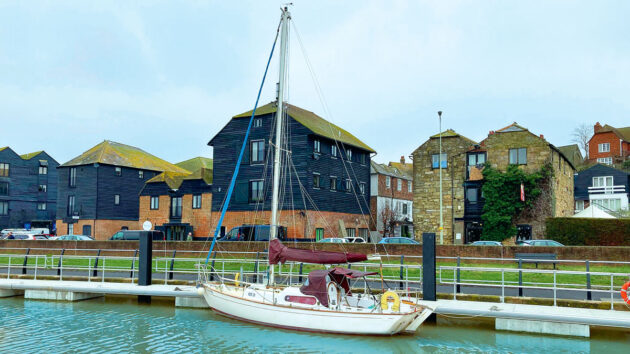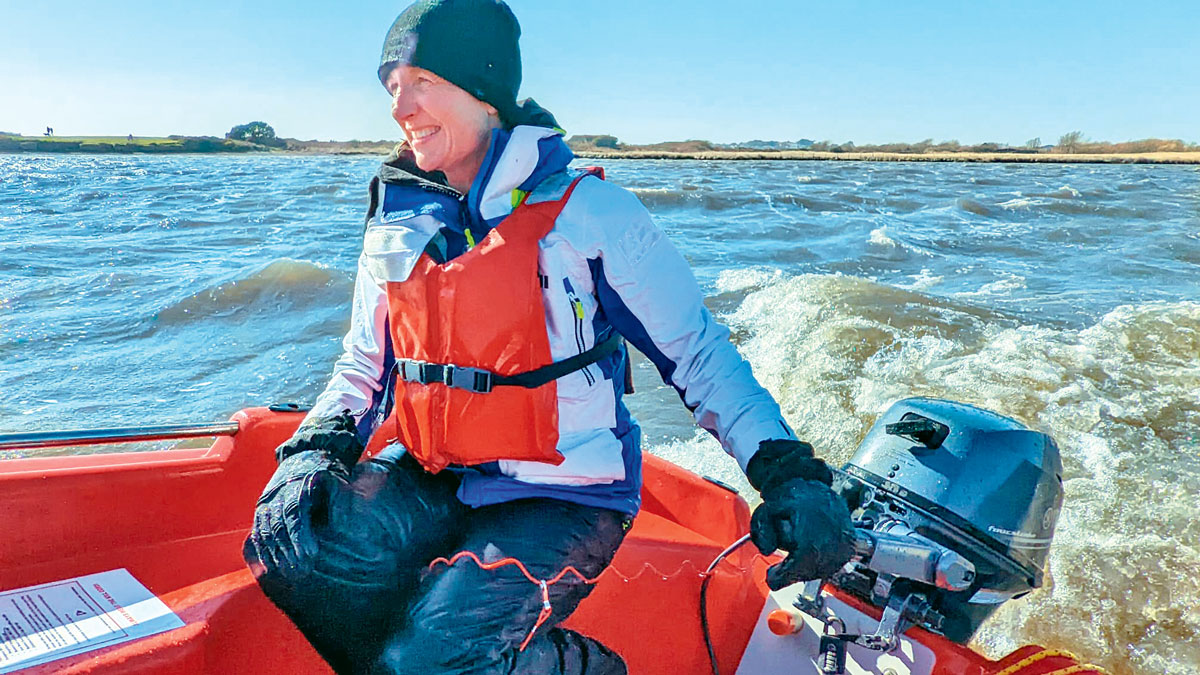Prolific small boat owner Clive Marsh recalls a conversation that led him to discover the Invicta 26 – a sea-kindly GRP vessel inspired by the Folkboat.
The once great British Merchant Navy was in decline. Ships were being mothballed and shipping companies were closing down.
London Docks were emptying and my own employer, Canadian Pacific Steamships, was down to only one passenger liner.
So, it didn’t take much imagination to see that employment and promotion prospects were bleak.
Perhaps it was time to go back to school and find another career.
It was December when my little general cargo ship was leaving the St Lawrence before the freeze to head out into the wild winter North Atlantic.
Around 1600 it was getting dark and my job was to keep the ship’s log, stand by the telegraph and attempt to interpret the instructions for relaying to various parts of the ship.
For the most part I did this phonetically.
As we passed some office blocks on our port side, I could see, through binoculars, people in warm, cosy offices.
I asked the captain what they all did, and he said, “They’re not like us, they’re accountants and people like that”.
When we got back to England, I bought books on accountancy instead of celestial navigation and eventually found myself an office role with a tanker company as a sort of nautical accountant.
Life was easy and I found time to sail dinghies.
I kept a foot in both camps but as the shipping companies closed one by one, I found myself working as an accountant for a manufacturing company in Tonbridge.
First Invicta 26 sighting
My office looked out onto the Tyler Boat Company yard.
Every few weeks marvellous yacht hulls would pass through their gates and one was the Invicta 26.
A perfect view for me since I have always preferred boats to ships and maybe one day I could afford one.

An inboard engine has been fitted; the outboard bracket is just a back up. Credit: Mick Kirby/RHSC
Folkboat inspiration
Based on the Folkboat, the GRP Invicta 26 was designed by Ericus Gerhardus (EG) van de Stadt.
Tylers moulded the hulls, and they were fitted out by a variety of boatbuilders.
There was a Mk1 model and a Mk2 version, which offered a little more headroom.
Later versions were moulded by FI-Craft in Essex and fitted out by FI-Craft or Salterns Yacht Agency.
Folkboats have great lines, but this comes with limited space below.
The Invicta 26 are often sold as families get bigger and tend to be owned by young couples or older sailors who sail without growing kids on board.
They have become a much-admired modern classic.
One was moored next to my boat near Strand Quay up Rock Channel at Rye.
I have watched her sail out in the Bay with different owners for many years and always admired her lines and performance.
She looked very comfortable and at home in her environment, riding the waves comfortably with no slamming or fuss.

Victoria’s classic caulked decks. Credit: Mick Kirby/RHSC
Mud benefits
The current owner is Mick Kirby at our sailing club.
His extensive overhaul includes a compact replacement Volvo MD 2010D engine with raw water cooling and a heat exchanger to cool the exhaust gases.
She looks better than ever, but keeping a boat looking clean when berthed in the Rye mud is a challenge.
She digs her keel into the mud and leans against the wall at Strand Quay.
One advantage of a drying mooring is less frequent antifouling. I once managed to go for four years with a fouling-free but muddy hull.
Perhaps because when the salty tide departs from Rock Channel, fresh water is let out of the River Tillingham, and this mix of fresh and salt water at each tide might confuse the Klingons I get in a marina.
Also, being dry for half of each day might help.
There are other local theories but whatever the reason, I prefer a nice mud berth to a marina. I prefer mud to barnacles any day.
Sea-kindly Invicta 26
Invictas have an excellent reputation.
In 2001, PBO’s sister magazine Yachting Monthly did a used boat test and said: ‘Invictas are sea kindly, knockabout cruisers that will keep a couple or young family safe in all weathers and embarrass some modern yachts with their speed.’
I can vouch for this, having observed Mick’s Victoria of Rye in a variety of sea conditions.
Of course, she might take a little longer to come round on a tack than a fin keel boat, but she is made for the sea and not for dodging around the buoys.
The transom-hung rudder joined to the end of the long keel looks robust and I wonder if these are less vulnerable to the playful orca attacks off Cape Trafalgar.
I like to be able to see my rudder when sailing. Ballast is encapsulated in the keel.
Keel conundrum

Victoria’s attractive low profile comes at the expense of interior size. Credit: Mick Kirby/RHSC
I have tended to avoid long- or fin-keel boats in favour of bilge keelers which I can beach more easily.
But at Rye, bilge keels are not so useful. Given the steep mud banks, a bilge keeler can not easily lay alongside a wall.
Even worse, one keel might find a hole.
For these reasons, bilge keelers tend to berth bow-on to the bank and then, when the tide departs, their rear end is left in the air.
Mick keeps his Invicta on a fully drying mooring ‘roped’ so that she leans against the wall when the tide goes out.
The long keel digs into the soft Rye mud.
One great advantage of a long keel is that antifouling is a lot easier to apply than it would be on a bilge keeler.
There is a slip with posts at Rye, and yachts can dry out (by arrangement with the harbour master) for a tide and a quick antifoul.
A lot less bother and expense than hauling the boat out at a yard.
Another similar boat to look at is the Contessa 26.
Dimensions for both boats are given (below) for comparison.
The prices of used Invictas vary, mainly according to the engine.
Some, that would benefit from a new engine, cost less than a good dinghy.

The Contessa 26 is a similar Folkboat derivative. Credit: Andy Arthur/Alamy
Invicta 26: approximate dimensions
Long keel, transom hung rudder
Rigging type: masthead sloop
LOA: 26ft 5in / 8.06m
LWL: 20ft 8in / 6.30m
Beam: 7ft 4in / 2.24m
Displacement: 5,137lb / 2,330kg
Ballast: 2,315lb / 1,050kg encapsulated
Max draught: 3ft 11in / 1.20m
Construction: GRP
First built: 1964
Builders: Tyler Boat Co & FI-Craft
Designer: EG van de Stadt
Contessa 26: approximate dimensions
Long keel, transom hung rudder
Rigging type: masthead sloop
LOA: 25ft 6in / 7.77m
LWL: 20ft 0in / 6.10m
Beam: 7ft 6in / 2.29m
Displacement: 5,400lb / 2,449kg
Ballast: 2,300lb / 1,043kg
Max draft: 4ft 0in / 1.22m
Construction: FG/GRP
First built: 1965
Last built: 1990
Builder: Jeremy Rogers
Designer: David Sadler
Best bilge keel yachts and twin keel yachts for drying out ashore
Back in the late 1970s, I found myself on the horns of a dilemma. For the last decade or so…
Buying a new or used outboard motor? Professionals share their tips to make sure you avoid the pitfalls
From horsepower to shaft length and tilt-angle to 2- or 4-stroke, Ali Wood highlights the different features you should consider…
Coming of age: the 1970s yacht designs that have stood the test of time
Sailing in the 1970s was characterised by innovation, enthusiasm, mass participation and home boatbuilding. Rupert Holmes reports
Want to read more boat articles?

A subscription to Practical Boat Owner magazine costs around 40% less than the cover price.
Print and digital editions are available through Magazines Direct – where you can also find the latest deals.
PBO is packed with information to help you get the most from boat ownership – whether sail or power.
-
-
-
- Take your DIY skills to the next level with trusted advice on boat maintenance and repairs
- Impartial in-depth gear reviews
- Practical cruising tips for making the most of your time afloat
-
-
Follow us on Facebook, Instagram, TikTok and Twitter







